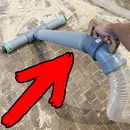Introduction: Camera Cage With LEDs
If you are into photography or videography you probably know that camera equipment can be quite expensive. Having the skills and knowledge to build some of that stuff yourself really cuts the cost. And who knows, you might just create something awesome and extraordinary.
I have been documenting my builds on Youtube for quite a few years now. As my main focus is usually on new tools I never seem to have the recourses to invest in camera equipment. Some time ago my father gave me our family's old video camera. It is not the newest nor the best piece of equipment but it does a decent job at capturing HD footage. As I was pretty happy with it I decided to invest some time and money into it.
I bought a wide-angle lens, small shotgun microphone and upgraded the battery. All this made the camera pretty bulky and uncomfortable to handle. It also missing lights. To solve the issue I decided to build a camera cage from a material I know best - wood. It turned out super nice and I really happy with the results. The two LED strips I run off of a 5V power bank and give out a really nice bright light for filming. Having a wider grip on the camera also increases stability while filming.
But enough talk. Let's see how I built it. Check out the video as well!
If you have any questions or suggestions please do leave them in the comments below. I would love to hear your thoughts and ideas!
Step 1: Tools & Materials
The camera I am using is Sony HDR SR11. The upgrades I did were:
I am really happy with these upgrades. I paid 110€ (plush shipping).
To build the cage I used:
- 12 mm plywood
- 35 mm dia. dowel
- Wood glue
- Small nails
- Masking tape
- Spray paint/varnish
- Two bolts for attaching the camera
To add the LED-s I used:
- 24V LED strip
- Micro USB to DIP adapter
- DC/DC Step-up module
- Switch
- Wire
- 5V Power bank
- Small enclosure
Tools I used:
- Table saw
- Router
- Cordless drill with wood bits
- Sander/sandpaper
- Measuring and marking tools
- Clamps
- Soldering tools
- Small files
- Voltmeter
Do not worry if you do not own a table saw and a router. I am absolutely sure you could do this project with just coping saw/jig saw/band saw as well.
Step 2: The Frame
To start off I cut two strips of 12 mm plywood. These were going to be the top and bottom of the cage. To determine their length I just placed two pieces of the dowel next to my camera and measured the distance that seemed comfortable. The width of the top piece was the same as the dowel´s (35mm). The bottom one I made quite a bit wider as it would help support the camera better and the frame could easily stand up on its own. I rounded the edges later to give a nicer look. I built this cage to specifically fit my video camera so there is no point in giving exact measurements.
Next up I cut two pieces of LED strip. This was leftover from my Light Up Mirror build version 2. You can find a link to the exact strip I used in the previous step. I really like these lights as they are pretty close to normal daylight and they are diffused meaning fewer shadows. One thing to note when purchasing LEDs is to check the shortest length you can cut it. In my case, it was 50 mm which was pretty neat. I decided to add two 250mm sections to the frame. The total width of the cage was 300 mm
To make the LEDs seem like part of the cage I decided to rout a little pocket for them. This could have easily be done with a jig saw or band saw as well.
I also cut two pieces of 35 mm dowel for handles. The length of those was also determined by what felt comfortable.
Step 3: The Frame Pt.2
Next up I drilled holes for routing the wires. I used a 5mm drill bit and a cordless drill for that. I planned on adding the switch to the top right corner so this is where the wires gathered. I thought it might be difficult to drill a hole through the handle but it went smoother than expected. One thing to note is that the hole in the handle lines up with the hole in the bottom piece.
Then I glued and nailed the frame together paying attention that I would not put any nails through the wires (that run through the handle).
To attach the camera to the cage I added two bolts. One was for actually attaching the camera and the other one was for keeping the camera straight. The location of these bolts was determined by carefully measuring. To make them flush on the bottom I countersunk them. I also made a little notch in the wood so I could remove the battery without taking off the camera.
The last thing to do on the cage was to sand it. I rounded over all the corners using my homemade disc sander. Probably not the best tool for that but it did the job. I have 80 grit sandpaper on it so it removes bulk material pretty easily. No project is complete without a little hand sanding (120 grit)
Step 4: The Electronics
To make the LEDs work I built a little "circuit". This consisted of a Micro USB to DIP adapter, DC/DC Step-up module and a switch. It was all enclosed in a plastic screw box that I cut in half.
To bride the USB adapter to the step-up module I used the switch - it fitted really nicely. As the module seemed to draw current even if the LEDs were not connected I added the switch to the + side to completely cut the circuit when not in use. The - side was bridged using a piece of wire.
By turning the little screw on the step-up module I adjusted the output voltage to 25 volts. You really have to turn that screw quite a lot to start seeing some changes. If you are asking me how this thing turns 5V to 24V I would answer "magic" (I have no clue :)
The whole thing fitted perfectly inside a screw box I found in my drawer. The enclosure I planned on using was just too bulky. I cut around 1/3 off of that box and rebuilt the missing wall from wood and hot glue. To have access to the USB port I filed a little hole. The enclosure was then glued to the camera cage with hot glue as well.
Step 5: Paintjob
Before starting with the paint job I masked the dowels, the wires, the switch and the USB port with masking tape.
I did two coats of matt black spray paint, then removed the masking tape on the dowels and did two more coats of spray varnish. I am pretty pleased with the look! It looks modern and high-end but you can still tell that it is made from wood.
Matt black makes everything more badass. Change my mind!
Step 6: Final Touches
Adding the LED strips was probably the hardest part of the whole build. Soldering the wires to the strip is a real pain and I do not really have a good recommendation on how to do it. I used a sharp knife to splice the silicone and reveal the contacts. Then I soldered some lead to those contacts and then connected the wires. It is not an easy task but patience is the key!
I did not get the LEDs to work quite from the beginning. When turned on they would just flicker. After adjusting the output voltage to 23V it worked nicely. As I was running the lights off of a power bank I had to somehow attach it. My good luck with this project continued as the camera´s hand strap held the power bank in place perfectly.
The last thing I did was to attach a hot shoe base for the microphone. I got mine from a hot shoe adapter I had purchased before I planned on building the cage. These things can be found on Amazon. Like this or this.
I also drilled a little hole on the bottom of the cage so that it could be attached to a tripod. Right now I just screw the tripod attachment bolt straight into the wood but I am probably going to add a T-nut or wood insert nut later.
Step 7: That´s It!
As always, thank you for following my project and kudos to you if you actually read what I wrote. I hope I have inspired you to build your own camera cage!
If you have any questions or suggestions please do leave them in the comments below. I would love to hear your thoughts and ideas!
I also invite you to subscribe to my Youtube channel and follow me on Instagram!
Take care
Andu

Participated in the
Woodworking Contest













